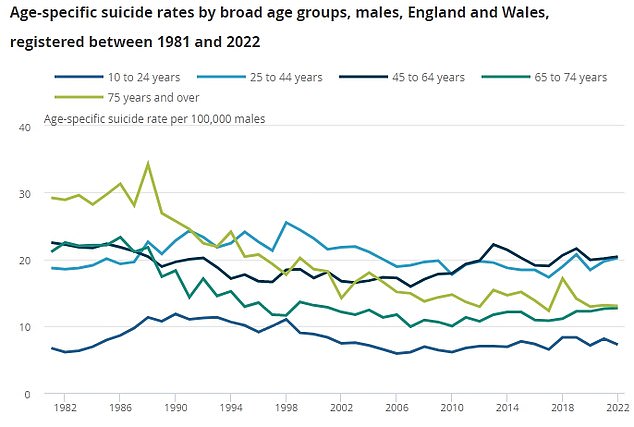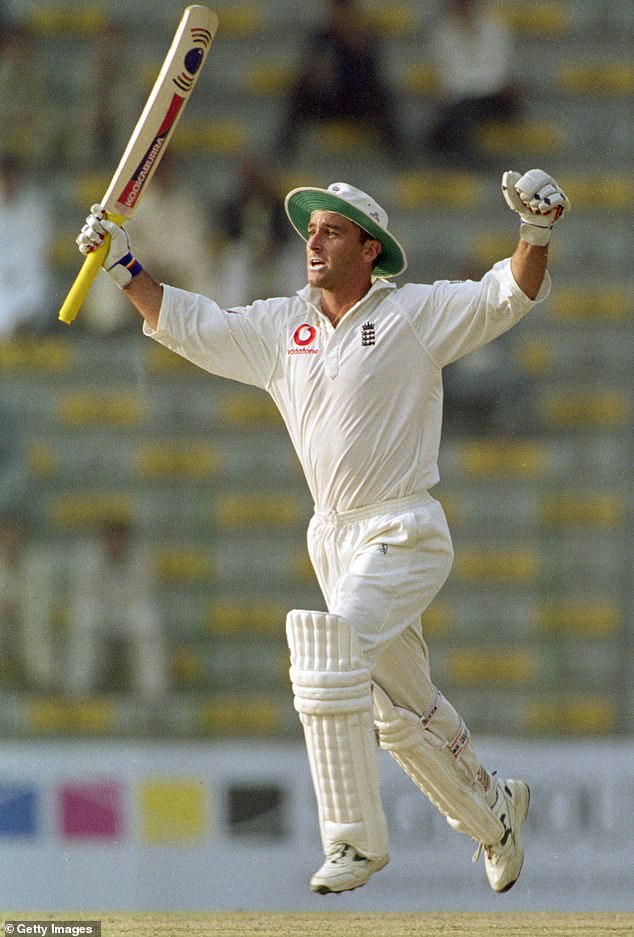Cricket hero Graham Thorpe took his own life on Sunday after years of battling severe anxiety and depression, believing his family were “better off without him”, his devastated wife has revealed.
The Surrey batsman, 55, was hospitalised two years ago after a previous attempt and despite “glimmers of hope” his mental health continued to deteriorate.
While each such case is as disconcerting as it is tragic, official data shows that men of their age are among the most likely to take their own lives in England and Wales.
In 2022, there were 5,642 suicides and three-quarters (71 per cent) were men, according to the Office for National Statistics.
Men aged 45 to 64 are most at risk and suicide deaths in this age group have risen steadily in recent years, despite declines in older and younger age groups, and experts who follow the issue have been trying to figure out why.
English legend Graham Thorpe took his own life, his family reveals
The most recent data show that 20 deaths per 100,000 are middle-aged men.
This figure is almost three times higher than the lowest rate among men (aged 10-24), which was 7.2 deaths per 100,000 people in 2022.
What’s behind these figures? The causes of suicide are always extremely complex, says The Samaritans, which warns against simplifying the causes or speculating on a “trigger”.
In its guidelines on how to report the problem, it adds:Most of the time there is no single event or factor that leads someone to take their own life.
However, Professor Nav Kapur of the University of Manchester’s Suicide Prevention Centre said financial concerns were a factor.
He said previous research has shown that in times of economic downturn male suicides in this age group increase, particularly in regions hardest hit by a recession.
“Middle-aged men are the most vulnerable to losing their jobs and not finding another one,” he said.
Professor Kapur added that as men of this age are more likely to view their work and their status as “breadwinners” as the cornerstone of their identity, losing this can severely impact their self-esteem.
Another factor is divorce. A 2012 report by the charity Samaritans found that divorced men were three times more likely to attempt suicide than married men.
This is thought to be because middle-aged men rely heavily on their wives for emotional support, and from the age of 30 onwards they also tend to have fewer friends than women in general.
The average age of divorce for men in the UK is 45.
Professor Stephen Platt, a health policy expert at the University of Edinburgh, has also attributed the high suicide rates among men of this age to the fact that they are increasingly isolated.
“We are thinking about the increase in female employment, births outside marriage, the increase in divorce and cohabitation, second and subsequent marriages, single-parent households, reconstituted families, single-parent living, couples and uncouples,” she said.
‘All of these trends mean that men are less likely to be with a life partner, and when you combine that with their difficulties in coping with emotions and being able to date and form new relationships with less support to fall back on than women, it makes them more vulnerable to poor psychological health conditions and suicide.’
Another factor Professor Kapur has highlighted is that men in this age group, as a generation, tend to have ideas about masculinity that could leave them more vulnerable to suicidal thoughts.
“They grew up with strong, silent, stoic fathers and male role models, but they live in a society that now values open and supportive ‘new men,'” she said.

England captain Nasser Hussain (left) and Graham Thorpe (right) celebrate after England won a historic series against Pakistan in 2000. They were best friends.

Official data from the Office for National Statistics for 2022 shows that suicide rates are highest among men aged 45 to 64 (black line), with 20.4 deaths per 100,000 people in this age group.
‘They are a generation that doesn’t really know who they are or how to be.’
To make matters worse, men’s traditional “coping mechanisms” for suicidal feelings can exacerbate these feelings.
Professor Kapur said: “When women are feeling unwell physically or psychologically, they are more likely to seek help, see their GP or share it with their peer group.”
He said men, on the other hand, are more likely to self-medicate with alcohol or drugs.
‘In the long term, alcohol acts as a brain depressant, lowering mood. In the short term, it can lead to impulsive decisions.’
Professor Shirley Reynolds, an expert in psychological therapies at the University of Reading, said another factor was that men, in general, were less likely to seek help for ailments, both physical and mental, than women.
“We know that men, on average, do not turn to the NHS for physical health problems as readily as women,” she said.
Professor Louis Appleby, chair of the Government’s National Suicide Prevention Advisory Group, also echoed these points: “Men are at greater risk of suicide because they are more likely to drink heavily, use methods of self-harm which are often more lethal, and are reluctant to seek help.”
This week, Graham Thorpe His wife Amanda and two daughters Kitty, 22, and Emma, 19, have spoken of his mental health and hope his battles on and off the pitch remain inspiring.
Mrs Thorpe said: “Despite having a wife and two daughters whom he loved and who loved him, he did not improve. He was very unwell in recent times and genuinely believed we would be better off without him and we are devastated by his attitude and his suicide.”
His two daughters have revealed that he rarely spoke of his legendary status as a cricketer, telling them he “hit the ball a bit”, and how much he loved his family and would “get up and dance anywhere and to anything”.
“That’s the Graham I know, remember and loved. Graham was a free spirit. My favorite memory of him is in Barbados, where he loved it, enjoying a rum punch and listening to his favorite reggae after a swim. He was handsome, very handsome. He was funny and made us all laugh a lot.” Mrs Thorpe told The Times’ Michael Atherton, her friend and former England team-mate.

England’s Graham Thorpe celebrates his century during the Second Test against Sri Lanka at the Asgiriya Stadium, Kandy in 2001, one of the finest innings by an Englishman abroad.
It is estimated that 6,000 Britons and 48,000 Americans die by suicide every year.
Suicide attempts are believed to be 10 to 20 times higher than these figures.
The latest ONS data recorded 5,642 suicides in England and Wales in 2022, around 10.7 deaths per 100,000 people.
Approximately three in four (74.1 percent of all suicides) occurred among men.
Overall, among men and women, those aged 50 to 54 had the highest suicide rate, at 15.2 deaths per 100,000.
Like men, women aged 45 to 64 had the highest suicide rate among women, at 6.7 deaths per 100,000.
- For confidential assistance, call the Samaritans on 116123 or visit a local Samaritans branch, or click on here For more details


